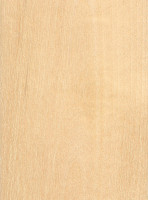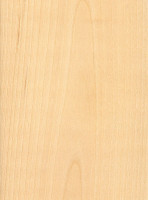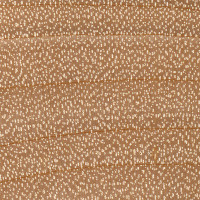 |
Common Name(s): Paper Birch Scientific Name: Betula papyrifera Distribution: Northern and central North America Tree Size: 65-100 ft (20-30 m) tall, 2-3 ft (.6-1.0 m) trunk diameter Average Dried Weight: 38 lbs/ft3 (610 kg/m3) Specific Gravity (Basic, 12% MC): .48, .61 Janka Hardness: 910 lbf (4,050 N) Modulus of Rupture: 12,300 lbf/in2 (84.8 MPa) Elastic Modulus: 1,590,000 lbf/in2 (10.97 GPa) Crushing Strength: 5,690 lbf/in2 (39.2 MPa) Shrinkage: Radial: 6.3%, Tangential: 8.6%, Volumetric: 16.2%, T/R Ratio: 1.4 |
Color/Appearance: Heartwood tends to be a light reddish brown, with nearly white sapwood. Occasionally figured pieces are available with a wide, shallow curl similar to the curl found in Cherry. There is virtually no color distinction between annual growth rings, giving Birch a somewhat dull, uniform appearance.
Grain/Texture: Grain is generally straight or slightly wavy, with a fine, even texture. Low natural luster.
Endgrain: Diffuse-porous; primarily radial multiples; medium pores in no specific arrangement, moderately numerous to numerous; parenchyma marginal, and sometimes diffuse-in-aggregates (faintly visible with lens); narrow rays, spacing fairly close to close.
Rot Resistance: Birch is perishable, and will readily rot and decay if exposed to the elements. The wood is also susceptible to insect attack.
Workability: Generally easy to work with hand and machine tools, though boards with wild grain can cause grain tearout during machining operations. Turns, glues, and finishes well.
Odor: No characteristic odor.
Allergies/Toxicity: Birch in the Betula genus has been reported as a sensitizer. Usually most common reactions simply include skin and respiratory irritation. See the articles Wood Allergies and Toxicity and Wood Dust Safety for more information.
Pricing/Availability: Likely to be rather economical in most instances. Figured boards can be more expensive, but normally plain birch lumber is in the same price range as maple or oak.
Sustainability: This wood species is not listed in the CITES Appendices or on the IUCN Red List of Threatened Species.
Common Uses: Plywood, boxes, crates, turned objects, interior trim, and other small specialty wood items.
Comments: Birch is one of the most widely used woods for veneer and plywood worldwide. Besides regular sheets of plywood, Birch veneer is also used for doors, furniture, and paneling.








I’m letting out to learn how to work paper birch for fine furniture since it grows abundantly where I live and with proper finishing does look rather attractive. Paper birch, however, is clearly not a substitute for yellow birch and there’s no comparison. If the dealer is reputable and the price is more than $5.00 a board foot it has to be yellow birch or they are swindling you. Rough or S1S paper birch should cost $2.50 to $4.00 a board foot. For S2S paper birch, you might go as high as $4.50, that’s it. Yellow birch is a march… Read more »
I noticed that paper birch is significantly softer and weaker than yellow birch or sweet birch. Since my hardwood dealer does not specify the kind of birch, how can I avoid buying the inferior (for my application) paper birch? I’m not sure how to distinguish paper- , sweet- , and yellow-birch.
Very much in the same boat, using birch for structural and hoping for yellow, but no way to find out what I am getting. The weights overlap so that’s not reliable.
Sure would love to find out how to separate yellow from rest.
Help?
Take a slice of paper birch with you when you go lumber shopping. Yellow birch has a denser/darker end grain than paper birch. Easy to tell when you hold them side by side.
Yellow birch has a denser/darker end grain than paper birch.